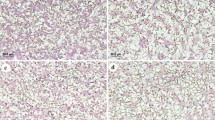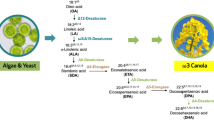Abstract
Fatty acid (FA) composition of fillet tissue can be tailored by transitioning fish from alternative lipid-based, low long-chain polyunsaturated fatty acid (LC-PUFA) grow-out feeds to high LC-PUFA “finishing” feeds. To address whether grow-out feed composition influences the responsiveness of fillet tissue to finishing, sunshine bass (SB, Morone chrysops × M. saxatilis) were reared to a submarketable size on grow-out feeds containing fish oil (FO) or a 50:50 blend of FO and coconut (CO), grapeseed (GO), linseed (LO), or poultry (PO) oil. For the final 8 weeks of the trial, fish were either maintained on assigned grow-out feeds or finished with the 100% FO feed. Production performance was unaffected by dietary lipid source, but fillet FA profile generally conformed to nutritional history. Regardless of grow-out regimen, finishing had a significant restorative effect on fillet FA composition; however, complete restoration of control levels of 20:5n-3, 22:6n-3, total LC-PUFA and n-3:n-6 FA ratio was achieved only among fish fed the CO-based grow-out feed. Saturated fatty acids (SFA) appear to be preferential catabolic substrates, whereas medium-chain and long-chain PUFA are selectively deposited in tissues. Provision of SFA in grow-out feeds appears to optimize selective FA metabolism and restoration of beneficial fillet FA profile during finishing.




Similar content being viewed by others
Abbreviations
- ANOVA:
-
Analysis of variance
- CO:
-
Coconut oil
- DHA:
-
Docosahexaenoic acid, 22:6n-3
- EPA:
-
Eicosapentaenoic acid, 20:5n-3
- FA:
-
Fatty acid
- FCR:
-
Feed conversion ratio
- FO:
-
Fish oil
- GO:
-
Grapeseed oil
- HSI:
-
Hepatosomatic index
- IPF:
-
Intraperitoneal fat
- IPFR:
-
Intraperitoneal fat ratio
- LC-PUFA:
-
Long-chain polyunsaturated fatty acid(s)
- LO:
-
Linseed oil
- MC-PUFA:
-
Medium-chain polyunsaturated fatty acid(s)
- MUFA:
-
Monounsaturated fatty acid(s)
- PO:
-
Poultry oil
- PUFA:
-
Polyunsaturated fatty acid(s)
- SB:
-
Sunshine bass
- SFA:
-
Saturated fatty acid(s)
References
Food and Agriculture Organization (2006) The state of world fisheries and aquaculture. Food and Agriculture Organization of the United Nations, Rome
Lands WEM (2005) Fish, omega-3, and human health, 2nd edn. AOCS Press, Urbana
Jump DB, Clarke SD, Thelen A, Liimatta M, Ren B, Badin MV (1997) Dietary fat, genes, and human health. Exp Med Biol 422:167–176
Williams CM (2000) Dietary fatty acids and human health. Ann Zootech 49:165–180
Duo L, Sinclair AJ (2002) Macronutrient innovations: the role of fats and sterols in human health. Asia Pac J Clin Nutr 11:155–162
Jahangiri A, Leifert WR, McMurchie EJ (2002) Omega-3 polyunsaturated fatty acids: recent aspects in relation to health benefits. Food Austral 54:74–77
Tapiero H, Ba GN, Couvreur P, Tew KD (2002) Polyunsaturated fatty acids (PUFA) and eicosanoids in human health and pathologies. Biomed Pharmacother 56:215–222
Duo L (2003) Omega-3 fatty acids and non-communicable diseases. Chin Med J 116:453–458
American Heart Association (AHA) (2004) Dietary guidelines: at-a-glance. http://www.americanheart.org/presenter.jhtml?identifier = 810. Accessed 18 Nov 2004
Pauly D, Watson D, Alder J (2005) Global trends in world fisheries: impacts on marine ecosystems and food security. Phil Trans R Soc B 360:5–12
Food and Agriculture Organization (2007) The role of aquaculture in sustainable development. http://www.fao.org/newsroom/en/news/2007/1000701/index.html. Accessed 19 Nov 2007
New MB, Wijkström UN (2002) Use of fishmeal and fish oil in aquafeeds: further thoughts on the fishmeal trap. Food and Agriculture Organization of the United Nations, Rome
Food and Agriculture Organization (2006) Fish oil market report—March 2006. http://www.globefish.org/index.php?id = 2759. Accessed 1 Apr 2006
Foran JA, Hites RA, Carpenter DO, Hamilton MC (2004) A survey of metals in tissues of farmed Atlantic and wild Pacific salmon. Environ Toxicol Chem 23:2108–2110
Hites RA, Foran JA, Carpenter DO, Hamilton MC, Knuth BA, Schwager SJ (2004) Global assessment of organic contaminants in farmed salmon. Science 303:226–229
Foran JA, Carpenter DO, Hamilton MC, Knuth BA, Schwager SJ (2005) Risk-based consumption advice for farmed Atlantic and wild Pacific salmon contaminated with dioxins and dioxin-like compounds. Environ Health Perspect 113:552–556
Bransden MP, Carter CG, Nichols PD (2003) Replacement of fish oil with sunflower oil in feeds for Atlantic salmon (Salmo salar L.): effect on growth performance, tissue fatty acid composition, and disease resistance. Comp Biochem Physiol B 135:611–625
Glencross BD, Hawkins WE, Curnow JG (2003) Restoration of the fatty acid composition of red seabream (Pagrus auratus) using a fish oil finishing diets after grow-out on plant oil based diets. Aquac Nutr 9:409–418
Wonnacott EJ, Lane RL, Kohler CC (2004) Influence of dietary replacement of menhaden oil with canola oil on fatty acid composition of sunshine bass. North Am J Aquac 66:243–250
Lewis HA, Kohler CC (2008) Minimizing fish oil and fish meal with plant-based alternatives in sunshine bass diets without negatively impacting growth and muscle fatty acid profile. J World Aquac Soc (in press)
Jobling M (2003) Do changes in Atlantic Salmon, Salmo salar L., fillet fatty acids following a dietary switch represent wash-out or dilution? Test of a dilution model and its application. Aquac Res 34:1215–1221
Jobling M (2004) Are modifications in tissue fatty acid profiles following a change in diet the result of dilution? Test of a simple dilution model. Aquaculture 232:551–562
Jobling M (2004) “Finishing” feeds for carnivorous fish and the fatty acid dilution model. Aquac Res 35:706–709
Robin JH, Regost C, Arzel J, Kaushik SJ (2003) Fatty acid profile of fish following a change in dietary fatty acid source: model of fatty acid composition with a dilution hypothesis. Aquaculture 225:283–293
Hunter BJ, Roberts DC K (2000) Potential impact of the fat composition of farmed fish on human health. Nutr Res 20:1047–1058
Regost C, Arzel J, Robin J, Rosenlund G, Kaushik SJ (2003) Total replacement of fish oil by soybean or linseed oil with a return to fish oil in turbot (Psetta maxima). 1. Growth performance, flesh fatty acid profile, and lipid metabolism. Aquaculture 217:465–482
Bell JG, Henderson RJ, Tocher DR, Sargent JR (2003) Replacement of dietary fish oil with increasing levels of linseed oil: modification of flesh fatty acid compositions in Atlantic salmon (Salmo salar) using a fish oil finishing diet. Lipids 39:223–232
Bell JG, Henderson RJ, Tocher DR, Sargent JR (2004) Replacement of dietary fish oil with increasing levels of linseed oil: modification of flesh fatty acid compositions in Atlantic salmon (Salmo salar) using a fish oil finishing diet. Lipids 39:223–232
Torstensen BE, Frǿyland L, Lie Ǿ (2004) Replacing dietary fish oil with increasing levels of rapeseed oil and olive oil—effects on Atlantic salmon (Salmo salar L) tissue and lipoprotein lipid composition and lipogenic enzyme activities. Aquac Nutr 10:175–192
Bell JG, McGhee F, Dick JR, Tocher DR (2005) Dioxin and dioxin-like polychlorinated biphenyls (PCBs) in Scottish farmed salmon (Salmo salar): effects of replacement of dietary marine fish oil with vegetable oils. Aquaculture 243:305–314
Izquierdo MS, Montero D, Robaina L, Caballero MJ, Rosenlund G, Ginéz R (2005) Alterations in fillet fatty acid profile and flesh quality in gilthead seabream (Sparus aurata) fed vegetable oils for a long term period. Recovery of fatty acid profiles by fish oil feeding. Aquaculture 250:431–444
Torstensen BE, Bell JG, Rosenlund R, Henderson RJ, Graff IE, Tocher DR, Lie Ǿ, Sargent JR (2005) Tailoring of Atlantic salmon (Salmo salar L.) flesh lipid composition and sensory quality by replacing fish oil with a vegetable oil blend. J Agric Food Chem 53:10166–10178
Lane RL, Trushenski JT, Kohler CC (2006) Modification of fillet composition and evidence of differential fatty acid turnover in sunshine bass Morone chrysops × M. saxatilis following change in dietary lipid source. Lipids 41:1029–1038
Turchini GM, Francis DS, De Silva SS (2006) Modification of tissue fatty acid composition in Murray cod (Maccullochella peelii peelii, Mitchell) resulting from a shift from vegetable oil diets to a fish oil diet. Aquac Res 37:570–585
Turchini GM, Francis DS, De Silva SS (2007) Finishing diets stimulate compensatory growth: results of a study on Murray cod, Maccullochella peelii peelii. Aquac Nutr 13:351–360
Lewis HA, Kohler CC (2008) Corn gluten meal partially replaces dietary fish meal without compromising growth or the fatty acid composition of sunshine bass. North Am J Aquac 70:50–60
Folch J, Lees M, Sloane-Stanley GH (1957) A simple method for the isolation and purification of total lipids from animal tissues. J Biol Chem 276:497–507
AOAC International (2003) Official methods of analysis. AOAC International, Arlington
Kohler CC (2000) Striped bass and hybrid striped bass culture. In: Stickney RR (ed) Encyclopedia of aquaculture. Wiley, New York, pp 898–907
Ballestrazzi R, Rainis S, Maxia M (2006) The replacement of fish oil with refined coconut oil in the diet of large rainbow trout (Oncorhynchus mykiss). Ital J Anim Sci 5:155–164
Higgs DA, Balfry SK, Oakes JD, Rowshandeli M, Skura BJ, Deacon G (2006) Efficacy of an equal blend of canola oil and poultry fat as an alternate dietary lipid source for Atlantic salmon (Salmo salar L.) in sea water. 1: Effects on growth performance, and whole body and fillet proximate and lipid composition. Aquac Res 37:180–191
Xue M, Luo L, Wu X, Ren Z, Gao P, Yu Y, Pearl G (2006) Effects of six alternative lipid sources on growth and tissue fatty acid composition in Japanese sea bass (Lateolabrax japonicus). Aquaculture 260:206–214
Menoyo D, Lopez-Bote CJ, Diez A, Obach A, Bautista JM (2007) Impact of n-3 fatty acid chain length and n-3/n-6 ratio in Atlantic salmon (Salmo salar) diets. Aquaculture 267:248–259
Nematipour GR, Gatlin DM (1993) Effects of different kinds of dietary lipid on growth and fatty acid composition of juvenile sunshine bass, Morone chrysops × M. saxatilis. Aquaculture 114:141–154
Bell JG, McEvoy J, Tocher DR, McGhee F, Campbell PJ, Sargent JR (2001) Replacement of fish oil with rapeseed oil in diets of Atlantic salmon (Salmo salar) affects tissue lipid compositions and hepatocyte fatty acid metabolism. J Nutr 131:1535–1543
Bell JG, Henderson RJ, Tocher DR, McGhee F, Dick JR, Porter A, Smullen RP, Sargent JR (2002) Substituting fish oil with crude palm oil in the diet of Atlantic salmon (Salmo salar) affect muscle fatty acid composition and hepatic fatty acid metabolism. J Nutr 132:222–230
Henderson RJ, Sargent JR (1985) Chain length specificities of mitochondrial and peroxisomal β-oxidation of fatty acids in livers of rainbow trout (Salmo gairdneri). Comp Biochem Phys B 82:79–85
Kiessling K-H, Keissling A (1993) Selective utilization of fatty acids in rainbow trout (Oncorhynchus mykiss, Walbaum) red muscle mitochondria. Can J Zool 71:248–251
Henderson RJ (1996) Fatty acid metabolism in freshwater fish with particular reference to polyunsaturated fatty acids. Arch Anim Nutr 49:5–22
Frǿyland L, Lie Ǿ, Berge RK (2000) Mitochondrial and peroxisomal β-oxidation capacities in various tissues from Atlantic Salmon, Salmo salar. Aquac Nutr 6:85–89
Torstensen BE, Frǿyland L, Ǿrnsrud R, Lie Ǿ (2004) Tailoring of a cardioprotective muscle fatty acid composition of Atlantic salmon (Salmo salar) fed vegetable oils. Food Chem 87:567–580
Crockett EL, Sidell BD (1993) Substrate selectivities differ for hepatic mitochondrial and peroxisomal β-oxidation in an Antarctic fish, Notothenia gibberifrons. Biochem J 289:427–433
Acknowledgments
We thank Andrew Coursey, Adam Lohmeyer, Shawn Meyer, Quinton Phelps, John West, and John Zeigler for assisting in data collection, and James Garvey and Michael Arts for editorial advice provided during manuscript preparation. We also thank Tyson Foods, Omega Protein, and Tate and Lyle for the donation of feedstuffs used in the present work, and the National Science Foundation for provision of funding under grant #0227925.
Author information
Authors and Affiliations
Corresponding author
About this article
Cite this article
Trushenski, J.T., Lewis, H.A. & Kohler, C.C. Fatty Acid Profile of Sunshine Bass: I. Profile Change is Affected by Initial Composition and Differs Among Tissues. Lipids 43, 629–641 (2008). https://doi.org/10.1007/s11745-008-3188-z
Received:
Accepted:
Published:
Issue Date:
DOI: https://doi.org/10.1007/s11745-008-3188-z




